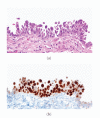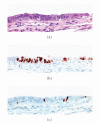Precursor lesions of high-grade serous ovarian carcinoma: morphological and molecular characteristics
- PMID: 20445756
- PMCID: PMC2860809
- DOI: 10.1155/2010/126295
Precursor lesions of high-grade serous ovarian carcinoma: morphological and molecular characteristics
Abstract
The lack of proven screening tools for early detection and the high mortality of ovarian serous carcinoma (OSC), particularly high grade, have focused attention on identifying putative precursor lesions with distinct morphological and molecular characteristics. The finding of occult invasive and intraepithelial fallopian tube carcinomas in prophylactically removed specimens from asymptomatic high-risk BRCA 1/2-mutation carriers supports the notion of an origin for OSC in the fallopian tube. The intraepithelial carcinomas have been referred to as serous intraepithelial carcinomas (STICs) but our own findings (unpublished data) and recent reports have drawn attention to a spectrum of changes that fall short of STICs that we have designated serous tubal intraepithelial lesions (STILs).
Figures


References
-
- Shaw PA, McLaughlin JR, Zweemer RP, et al. Histopathologic features of genetically determined ovarian cancer. International Journal of Gynecological Pathology. 2002;21(4):407–411. - PubMed
LinkOut - more resources
Full Text Sources
Other Literature Sources

